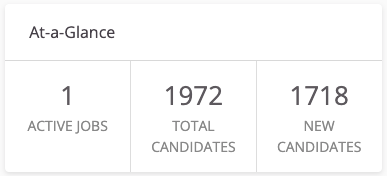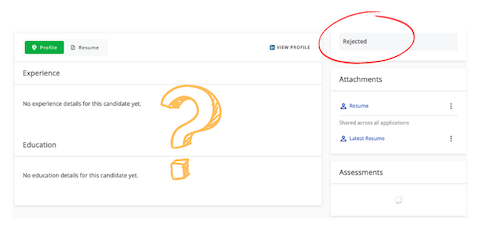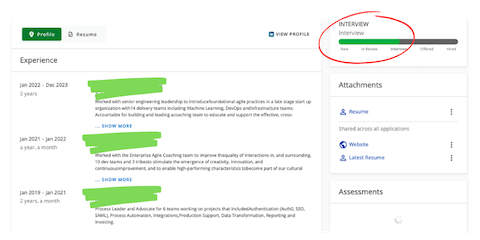How we chose one stellar Agile candidate out of 2,000
This is a true story. We were just 28 short of hitting 2,000 applications for one Sr. Scrum Master position. But I’m rounding up.

It was a good problem to have. You might wonder how we approached such a monumental task, so we’ll tell you. You also might wonder how we found one candidate that stood out from all the others. We’ll let you know that too. Read on to learn more about our learnings, from the first review of the resumes, through the prescreening call, the interviews, and then the final cut.
I’d like to tease that there are some insightful aha’s coming up, but unfortunately, the truth is, all the information is out there. That’s right. In nearly 2,000 resumes, we didn’t see anything new. But we saw a LOT of old, bad, and ugly.
Resume Truths
Here are some hard facts:
- We never read the fourth page of a resume. Or even the third. Hard Stop.
Career Coach & Corporate Consultant, Cristina Liriano, recommends one page for a mid-level professional and two pages for more advanced candidates with over a decade of experience. “Most recruiters and hiring managers only read highlights; they don’t have time to read every bullet point and want to scan as quickly as possible. Use your space wisely; be concise and specific.”
- I reiterate Cristina’s statement about “being specific.” If a resume had a list of meaningless bullets, we moved on. We’ve read the Scrum Guide; repeating the accountabilities of a Scrum Master was not a good use of a resume. We were seeking to understand how candidates applied professional agility.
- If their Agile resume was full of Project Management language — we wished the person well and moved on. We practice business agility and continual improvement through empowering people and enabling flow vs. managing a project. Enough said there.
- If an applicant tried to show they could do all the things, instead of showing a clear path of progressive responsibilities related to our needs, we kept looking — we believe we are better when we work to our strengths.
Read on to learn what caught our attention in the application process.
Application
If someone submitted a resume and chose not to fill out the application form online, they missed the opportunity to make their summary and recent experiences visible. We get it; cutting and pasting a resume into an online system is repetitive (and surprising nowadays). But for those that did, it helped us see their potential fit easier and faster. Here are screenshots of what our system displays to the hiring manager:


- Good formatting! The cleaner and more straightforward the resume, the better. We searched by keywords, of course. We also searched for companies who were solving problems at the same scale we are, and we searched for similar domain experiences.
- Certifications: If a resume listed credentials that indicated professional level-setting in a competency we were explicitly seeking, we looked further for meaningful descriptors that showed the application of that competency. If a candidate held a certification that didn’t relate to their professional journey, it didn’t carry vital significance.
- Evidence: Data is king. Imagine how reading about decreased time to market, lowered defect rates, or increased product value delighted agilists! If the resume was from a junior candidate but listed impacts and metrics, we reached out to learn more about their potential and build a relationship. While this opening was not the right opportunity for a less experienced Scrum Master, we always seek to develop our pipeline. If you were one of those candidates — we are glad you applied!
“Measurable results are a key component to any good resume. While a list of responsibilities is how we traditionally shared our experience to differentiate ourselves today, we are now looking for achievements. And we all have them — delivered 90% of projects on time, helped improve response time SLA by 15%, etc. Make sure you transfer some of your responsibilities into measurable results. A good amount to aim for is three.” Cristina Liriano, Career Coach
- Personal referrals. Nothing helped more than the power of a personal referral. We honored the time and effort it took for someone in our networks to speak up on a job seeker’s behalf. That urged us to take a look, and sometimes a second and third look. Ultimately, our final candidate came to us through a personal referral.
These aren’t only tips from our experience.
Cristina Liriano shared that “many companies are using Applicant Tracking Systems (ATS) that score your resume based on specific parameters. One of those is the Measurable Results component explained earlier. Like your credit score, this component has a higher weight in scoring. Oftentimes, if you do not score above a certain amount, you get filtered out, so the hiring manager never even sees your resume. It’s important to do your homework so your resume makes it through the hiring company’s screening software.”
Prescreens
We prescreened dozens (and dozens and dozens) of candidates with short intro phone calls. At this stage, the decisions became harder since most of the initial interviews were very strong. However, some patterns emerged that helped us curate the candidate list further:
- Too little investment. A few people had the surprising audacity to interview without learning anything about us. We spent effort learning about candidates before we engaged with them, so it was disappointing when someone told us they didn’t know what we did. Frankly, it’s hard to recover from that faux pau in the short time box of an interview.
- Too much experience. Sometimes, people were just too strong. That’s right — even looking out a year or more, we felt, given our current opportunity, some of the more experienced candidates would seek greater challenges in the immediate horizon. We’ll keep a relationship with those who made our shortlist to call them back when we mature.
- The unfortunate fact about money. I’ve recently seen many interview guides recommend that candidates should never declare their salary requirements upfront. While I understand the negotiation approach, that strategy isn’t helpful within the typical American hiring system. When asked, many candidates threw out salary ranges that were so far out of the range of the position we felt it would be a waste of everyone’s time to move forward. For those within $15–20K (US) of our salary range, we continued the interview process with a plan that the ideal candidate may justify an exception. Were they actual salary requirements or just a negotiating tactic? I don’t know — I sincerely hope each candidate finds what they seek.
Interviews
We include more people in the interview process as the right candidate approaches a possible offer. Our interviews are typically behavioral-based: we describe a scenario and ask how the candidate has approached something similar in the past, or if they haven’t had the experience, what they think they might do if faced with the situation. Here’s where some answers went sideways:
- People repeating their resumes hinted at poor preparation. Interviews are a chance to glimpse the impact people can make, not a repeat of what is listed on a resume.
- People who didn’t directly answer the question. This isn’t politics; it’s an interview. We really wanted to hear their thought process and choices.
- Long, rambly answers. Some folks lost us when it took 4–5 minutes for a single reply. The impact was they lost the chance to tell us more about what they could bring to the table through additional questions and answers.
Final Candidates
Our hiring journey came down to a small group of very diverse candidates. From there, it became about two discussion points within our team. To answer these two final questions, we back up to a few months ago when we spent several days together in a team summit. We got to know each other deeper, explored our collective capabilities, and were honest and vulnerable about our knowledge gaps. When we met to provide feedback on the final interviews, we were unified in the candidates we felt would be the best, long-term fit.
- Culture fit. Is this person “beerable?” We don’t mean “bearable,” we mean, would we want to grab a drink (of choice) after work with this person? Do we feel they would fit with our team and organizational culture?
- Current skill gaps. What secondary skills would benefit our team and organization, both now and in the next few years? This final question ended up being the differentiator. Our new employee brings deep experience in an area we know is a gap in our group skillset.
One last piece of advice from Cristina is to let your personality shine through.
“If you are funny and charming, do not be overly serious in the interview. On the other hand, if you are shy and withdrawn, be prepared to share a story about work, so people in the interview connect with you. Don’t just focus on answering their questions transactionally, be the human you are. Being a good fit is more important than just being able to do that job. We’re humans, not robots.”
Are you an Agile professional seeking some actionable resume help from another agilist? No matter your experience, we recommend Touchstones (and Cristina Liriano.) You can contact them (and read solid interview preparation advice) here.
Julee Everett with Cristina Liriano
Hone your craft, Speak your truth, Show your thanks
To get full access to thousands of writers, and every story on Medium, consider becoming a Medium member using this link. Your membership fee directly supports Julee Everett and other writers you read.
Visit Julee Everett’s YouTube Channel for growing library of webinars and conference talks.







